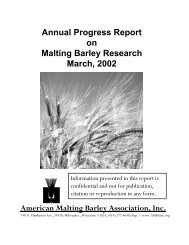Annual Progress Report on Malting Barley Research March, 2007
Annual Progress Report on Malting Barley Research March, 2007
Annual Progress Report on Malting Barley Research March, 2007
Create successful ePaper yourself
Turn your PDF publications into a flip-book with our unique Google optimized e-Paper software.
A-Chain<br />
A-Chain<br />
A-Chain<br />
B-Chain<br />
C-Chain<br />
Figure 4. Porti<strong>on</strong> of an idealized starch (amylopectin) molecule. Gray circles show<br />
glucose residues that would be removed by beta-amylase in the preparati<strong>on</strong> of betalimit<br />
dextrin substrate. Striped circles show residues within the beta-limit dextrin that<br />
would be susceptible to beta-amylase <strong>on</strong>ly after initial treatment with alpha-amylase.<br />
Methods and Results. In the first porti<strong>on</strong> of this study high performance size exclusi<strong>on</strong><br />
chromatography (HPSEC) was used to compare the change in the molecular weight of<br />
the beta-limit dextrin (HPSEC) substrate to the loss in iodine binding when incubated<br />
with alpha-amylase. As shown in figure 5, there was more than a 7-fold reducti<strong>on</strong> in<br />
molecular weight within the first min of reacti<strong>on</strong>, while iodine binding was <strong>on</strong>ly lost<br />
slowly. The absorbance at 12 min corresp<strong>on</strong>ds approximately to the end-point of the<br />
manual method. These results suggest that fragments of the beta-limit dextrin well<br />
below 30 kDa still show c<strong>on</strong>siderable iodine binding. As this extensive degradati<strong>on</strong> is<br />
required to achieve the color end-point, the presence of substrate that is susceptible to<br />
beta-amylase is likely to influence the final results.<br />
80
















